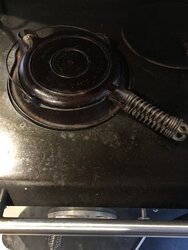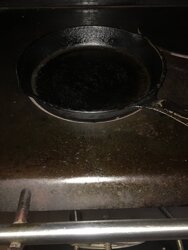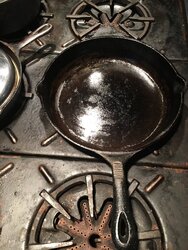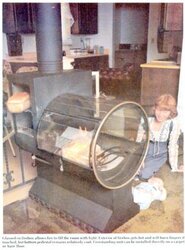I'm surprised this thread hasn't mentioned other Amish built cookstoves from Pioneer, Margin or Ashland. Your counter layout is designed for a left hand firebox, which most stoves are since the firebox must be on the left to be considered a "Baptist Stove". I did extensive research including factory visits, phone and email conversations with the builders before going with the Queen.
The Vermont Bun Baker ended up last on my list since it was the least capable for water heating and cook top area. The Pioneer brand Maid and Princess were pricier than the Bakers Choice which is very basic and a smaller footprint. (All Suppertime Stoves, an ex-Amish builder in Canada) All those cookstoves are made with gauge steel, so heavy duty use (canning) can cause warping or needing repair over many years of service. All those also have smaller capacity water tanks than my choice of the Queen. They have been the most desirable for Amish due to cost and a larger builder than the original Queen by Freeman Troyer that started in Michigan.
Another reason I prefer Amish built stoves is the gaskets used are flat, folded in half and pressed into a slot. They can be replaced while the stove is in use, compared to any that require cement or glue that need to be cold. This was our only heat source, so I also stayed away from fancy glass doors in case of breakage. Glass also radiates heat through the front, and standing in front of a cook stove cooks the front of your legs if they don't have a double wall door with airflow between. The Queen also has a full brick width firebrick across the front to keep cool standing in front. This was a main reason for no longer using a Fisher in the kitchen, as well as a larger cook top, then realized the capability of hot water.
Other reasons we chose the Queen;
1) Oven circulation is counterclockwise instead of circulating top down like most oven designs. They all leave a gooey residue under oven condensing water vapor and soot making a mess. Flames that exit sideways across bottom, up the side and across top to chimney vent stay much cleaner around oven.
2) The ash pan is a scoop design. Nothing falls behind it needing shoveling out. This causes ash to become airborne.
3) The oven interior was stainless with nickel racks.
4) Adjustable door hinges for tightness.
5) The largest water cistern for heating domestic water of any cookstove at 24 gallons. (new Grand is 17)
I believe the new Grand Comfort is the only secondary burn cookstove on the market. It is 700#, 100 lbs. lighter than the Queen 480, and heats 1000-2000 sf compared to the 480's 1000-2400. They all use 6 inch now, my older 480 having 7 inch with maximum heating capacity up to 3000 sf. The new Grand Comfort has a footprint of 44 X 34 with a cook top of 38 X 18. The 480 footprint 51 X 32 with a cook top of 43 X 21.
The firebox is smaller in the 500 with secondary burn and holds 17 inch wood. 480 holds 19 inch.
All the Kitchen Queen stoves are capable of stainless steel water heating cistern that takes 2 inches of cook top and an optional stainless coil in the firebox. These stoves are designed to be used as the only hot water source in an Amish home, so the coil can connect to the bottom of tank to circulate through tank, heating the water faster than only top surface contact. This requires a LOT of hot water usage or it will steam in the vented tank, over humidifying the home. For this reason I did not install the coil (3/4 stainless steel pipe like black iron screwed together in a horse shoe shape). The coil in your case would be connected to pipes rising to the second floor through radiation, without the need for pumps. When mine was purchased years ago none had thermostats, so I added my own. Most have thermostats now.
If looks is more important than function, Margin are really nice stoves, at a price. For a no frills workhorse you can't beat Bakers Choice, for me the Queen had the most bang for the buck and was the most heavy duty.
As far as heating in shoulder season, I build a fire each night. A summer grate is available for even less heat. You can't use the oven with summer grate, but you can cook if the power is out. Always cook on the stove top with lid removed for direct contact or you have nothing more than slower wood stove cooking. We have a commercial Garland double oven, 6 burner with broiler and my wife would rather cook with wood. The oven simply bakes and cooks better since wood ovens do not circulate air to dry food like electric or gas requires air flow around food.
The Queen, unlike most has a direct opening slider that opens into the exhaust vent for starting and summer use to prevent the stove from heating the home.
I don't know if the North Wood Cookstove can do that, but I see it doesn't have a scoop type ash pan and has some cast iron parts. Grate and outlet, which on antiques is subject to crack. I personally stay away from cast iron parts on the stoves I use, since my first cookstove was a cast iron stove and the antiques I restore are constantly in need of cast parts. Steel is just easier for me to weld, bolt, or modify than any cast parts. (And I kinda like Fishers that was the first welded steel plate stove, so it's only steel plate for me. I deal with enough cast parts on steam engine castings)
Here is a short video of the Grand Comfort with developers Joe Anderson from Knoxville Stove Works, Ed Semmelroth; Antique Stoves.com, and Duane Miller, owner Kitchen Queen. This shows the secondary air outlets on the sides that differ from wood stove tubes. (they have tubes on top too) They use a fiberboard baffle on top which has to affect stove top temperatures. The exhaust has to travel above it to heat the stove top. If I tried one I might like it, but moving them is a real hassle.
watch
They are all experimenting with coal including Suppertime and some Amish are using it. The problem is the coal varies so much from mining regions that what is used for firebox design and testing is not what is being used by the customer where the stove is delivered with mixed results. They are not UL listed for coal use.






